Leonardo Da Vinci and the Codex on Bunnies
Downtown Birmingham is deserted, even the trees are bare and there’s hardly any sign of life, save the occasional car on the interstate somewhere up above, propped aloft on concrete pylons. There’s a far too bitter wind for October in the South; it cuts around the brick edifices and concrete parking garages.
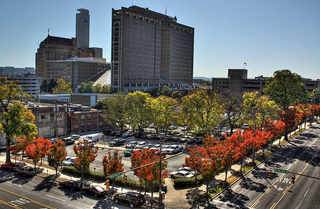 I’ve come to Birmingham for Da Vinci. He of the Mona Lisa, the Sistine Chapel and the Codex of Birds.
I’ve come to Birmingham for Da Vinci. He of the Mona Lisa, the Sistine Chapel and the Codex of Birds.
You wouldn’t expect Da Vinci in Birmingham Alabama, it of the civil rights struggle, much more readily conjured as a synecdoche of mediocre backwaters everywhere.
Yet here he is.
Or his notebooks anyway.
Rather, something in my head kept saying, for no reason I could deduce, go to that exhibit. In hindsight I now know that I needed to go for the bunnies.
But let’s start at the beginning, the warm, red-lipped smile from the middle age woman who collects my ticket, the very nice white-haired gentleman who hands me a brochure on Da Vinci and his notebooks, the other elderly gentleman in a blue docent’s vest who directs me to the back of the line.
Oh yes, the line.
Over two hours worth of people backed up, snaking through the main foyer, up the staircase to the second floor, around the landing and then inside some hidden room where, under glass and guarded by more museum security than I’ve ever encountered anywhere else combined (Da Vinci may have come to Alabama but clearly no one trusts Alabamians to react well to his arrival), the drawings await us.
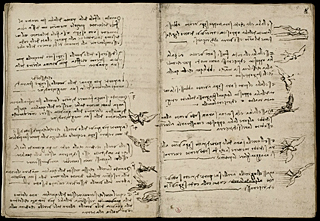 Imagine for a moment if, some 500 hundred years from now, a few pages torn from your notebook could draw thousands of people from around the world.
Imagine for a moment if, some 500 hundred years from now, a few pages torn from your notebook could draw thousands of people from around the world.
Be a bit strange wouldn’t it? But never mind that.
I suspect that, had Da Vinci’s codex of birds arrived in Birmingham Alabama say ten years ago, I would likely be standing alone right now. But then there was that damnable Da Vinci Code book.
Yes. I’ve read it. It was once the only English language book on Ko Muk where I was once trapped for while. It was just me, an Australian who told me with a straight face that he was an ex-lifeguard, a grumpy collection of Thai guesthouse staff, three naked Swedish girls and that damn book. I read it in three hours.
But I digress.
We need to get to the beginning. Further back than just the museum, further back than the curator who set up the show, further back than Italy from whence it came, probably all the way back to Da Vinci himself, who once made some doodles in a notebook, drawing people, drawing birds, drawing horses.
To keep things short we’ll setting for the moment I first encountered the bunnies.
The week before I left to travel the world, months before I would read The Da Vinci code, years before I would go to Birmingham, Alabama, I went up to San Francisco to visit Mike and Hilary. Bill drove, fun was had as I recall. For me the thing that sticks out though are the bunnies on the wall (well, that and the wolf coughing in the living room, but that’s another story).
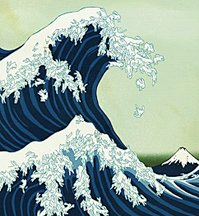 The bunnies were on the wall. Two dimensional bunnies. There were posters of bunnies. Specifically Kozyndan’s poster of various famous Japanese paintings recast with bunnies. Where there should be sea foam there were bunnies. Where there should have been leaves, there were bunnies. Where there should have been cherry blossoms, there were bunnies.
The bunnies were on the wall. Two dimensional bunnies. There were posters of bunnies. Specifically Kozyndan’s poster of various famous Japanese paintings recast with bunnies. Where there should be sea foam there were bunnies. Where there should have been leaves, there were bunnies. Where there should have been cherry blossoms, there were bunnies.
There were bunnies everywhere damnit.
Prior to seeing those images I’m not sure I ever gave bunnies much thought (several months later in Austria I would eat a bunny and be somewhat unimpressed), but there, hanging on the wall of a San Francisco apartment, were posters of bunnies, hundreds of bunnies, thousands perhaps and I, for the first time, I was forced to think about bunnies. Bunnies in places you would not expect bunnies.
You can see where, if, shortly after seeing such a thing you suddenly had roughly an entire year’s worth of free time in part of world where beer is about 25 cents a pint, you might develop something of an obsession with the bunnies in places where there should not be bunnies (what if, instead of rats running around this hostel, there were bunnies? And so on).
I did a bit of googling and discovered that the artist(s) have something of a bunny fetish, bunny fish, bunnies in winter, bunnies in a crowd and so on. When I got back one of the first things I did after I had a roof over my head was order my own copies of the bunny posters.
Of course none of that prepared me for the Ur Bunny in Birmingham.
Eventually the long line to see the Da Vinci exhibit made its way up the stairs and around the second story, through a smallish exhibit of Asian art. Finally, I thought, at least there is something to do while I wait, some art to examine.
As the line wound around the room, there were a number of interesting pieces, but in the corner I spied something that looked like a traditional Japanese or perhaps Chinese landscape paintings — a tree in fall, some mountains in the background and some, wait a minute, are those bunnies? Holy crap, they are bunnies and they have glowing red eyes.
There, fortunately restrained under protective museum glass, was a Chinese landscape populated by red-eyed bunnies, lurking under trees, trying, but failing, to look innocent.
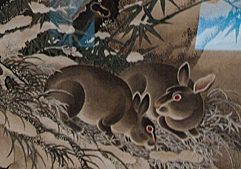 I had plenty of time to confront the bunnies, to study them in the their natural watercolor state and it didn’t take long to feel there was a noticeably evil glint in their eyes, as if wary of being caught in the act of colluding on some nefarious project, almost certainly some sort of world takeover scheme — not unlike what the conspiracy theorists attribute to Da Vinci, but so much sneakier because no one expects the bunnies.
I had plenty of time to confront the bunnies, to study them in the their natural watercolor state and it didn’t take long to feel there was a noticeably evil glint in their eyes, as if wary of being caught in the act of colluding on some nefarious project, almost certainly some sort of world takeover scheme — not unlike what the conspiracy theorists attribute to Da Vinci, but so much sneakier because no one expects the bunnies.
Bunnies are cute. Bunnies do not generally attack. Of course there was that incident in The Holy Grail and, as we all know, humor has a way of cutting much closer to the truth, but still, bunnies are harmless right? Cute, fluffy little things… but what’s with the red eyes? The artist clearly did not have cute fluffy little things in mind when he painted these bunnies.
Red-eyed things are zombies, re-animated nightmares, conspiratorial evil plotting against us. Now I understand the kozyndan posters, they’re a warning, a vision of future where bunnies have taken over the sea, the mountains, become like water, like snow, like wind to meld themselves irreversibly into the fabric of our existence.
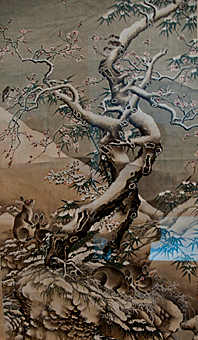 Think about, with the birthrate of bunnies it wouldn’t take but a couple of years for properly conditioned bunnies to replace nearly every atom of our existence with themselves.
Think about, with the birthrate of bunnies it wouldn’t take but a couple of years for properly conditioned bunnies to replace nearly every atom of our existence with themselves.
Here’s what I know: the Ur bunnies have glowing red eyes and while Da Vinci did not, so far as we know, produce a Codex of Bunnies, given his secret society connections, he surely must have known of the Ur bunnies. Known enough to hide the codex and hide it well.
As for the stuff he didn’t hide quite as well, well, it was interesting, perhaps even illuminating, but somehow it seemed suddenly unimportant in the face of the inevitable bunny onslaught. Remember, you read it here first.
Thoughts?
Please leave a reply:
All comments are moderated, so you won’t see it right away. And please remember Kurt Vonnegut's rule: “god damn it, you’ve got to be kind.” You can use Markdown or HTML to format your comments. The allowed tags are
<b>, <i>, <em>, <strong>, <a>. To create a new paragraph hit return twice.